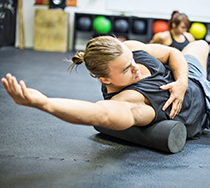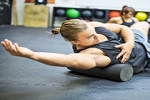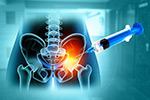
In the past few years, foam rolling (AKA self-myofascial release) has become an integral part of many athletic training programs due to its performance enhancing and rehabilitative benefits. Foam rollers can be carried and used practically anywhere. In fact, athletes can even be seen using them at airport terminals during a layover!
Foam rolling seems to offer the perfect solution when coping with the rigors of a demanding sports season that can cause tightening of muscles and the formation of “knots” or trigger points. While foam rolling, your own bodyweight is used to apply controlled pressure to sore muscles, causing release of the hardened muscle knots and trigger points. A relaxed muscle has greater range of motion and flexibility, which improves athletic ability. Foam rolling has also been known to reduce delayed onset muscle soreness and speed up recovery following strenuous activity.
Here are some of the popular foam rolling exercises that can be incorporated into your pre-workout warm-up and cool-down routines.
- Glutes: Sit on the floor with your legs extended in front of you. Place the foam roller under your glutes perpendicular to your legs. While supporting yourself partially on your hands, angle your body such that one butt cheek bears most of your body weight. Move the glute back and forth over the roller. Tight glutes can cause pain in the knees and lower back region, which can be alleviated using this exercise.
- Hamstrings: Sit on the floor with your legs straight. Place the foam roller under your thighs perpendicular to your legs. Using your arms, shift your weight such that the foam roller moves from the bottom of your thighs to the bottom of your glutes slowly, thoroughly stretching the hamstrings. The exercise will help loosen tight hamstrings and reduce low back pain.
- IT Band: Position yourself on your side with the foam roller placed just under your hip. Move your body over the roller from just below the hip to the top of the knee while supporting yourself with your opposite foot and your hands. This exercise can be used to prevent IT band issues commonly associated with running or other high-impact activity.
- Upper Back: Lie on your back with your upper back against the foam roller. Lift your hips off the floor and move your back over the roller from your midback to the level of your shoulders. This is a great way to loosen up tight muscles in your upper back and release tension from your shoulders.
It is important to move slowly when performing foam rolling exercises, but avoid spending more than 20 seconds on a tight muscle knot or trigger point. With regular practice, you should notice improved range of motion and flexibility of your muscles, allowing you to produce your best on the playing field.
Dr. Domb is a nationally recognized orthopaedic surgeon specializing in sports medicine and arthroscopic surgery of the hip, shoulder and knee. A noted pioneer in advanced new techniques in hip arthroscopy, he delivers innovative treatments for patients with hip injuries such as impingement and labral tears. Dr. Domb is also an expert in arthroscopic surgery of the shoulder and knee, adept in specialized techniques including arthroscopic rotator cuff repair and all-inside ACL reconstruction.





